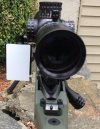K9TXS
Well-Known Member
Yes it does. Mounts straight to the rifle.And then the scope and rings transfer over to the rifle's scope base(s)?
 Help Support Long Range Hunting Forum
Help Support Long Range Hunting Forum
Yes it does. Mounts straight to the rifle.And then the scope and rings transfer over to the rifle's scope base(s)?
Yeah, that's it...It's a.....
289-100-000WB
EXD Engineering Vertical Reticle Level Instrument.
Mfr Part: VR3 from Brownells.com, $56.99
I have a question.
So lets say you send a practice round at a small rock on a hillside at say 650, and the bullet lands a bit to the right or left of the target.
Are you going to just sit there and evaluate what caused that?
Or would you make a correction and send another one?
Whats the difference what caused it, get over it and move on.
We dont live in a perfect world, yet for some reason many feel we can perfect things like first round hits at long distances.
There are obviously 2 different worlds we live in here.
Real world and dream world.
In a land and time far, far away, I sometimes quite enjoyed "fire for effect" excursions....not directly on my dime.Because some of us like to hit the rock on the first try instead of accuracy through volume.
Beyond me why anyone would want to dial windage into their come ups.
Well see you full well know that your statement is dreamworld.Because some of us like to hit the rock on the first try instead of accuracy through volume.
Beyond me why anyone would want to dial windage into their come ups.
I would have never thought of doing it this way. But from now on I'm going to use this method.I level up the action, cinch it down where it can't move and use a plumb bob to get the reticle level.
I've found that this one with a plumb bob works great and for the life of me at this time I can't recall the name, I'm sure you could find it in a search. It's old school but works great.
View attachment 359080
Pretty much the same as the level right pro but with out the light to shine through the optic or the target board.I've found that this one with a plumb bob works great and for the life of me at this time I can't recall the name, I'm sure you could find it in a search. It's old school but works great.
View attachment 359080
I think that "leveling the rifle", adds a measure of context to the rifle. While as long as the scope is plumb and aligned parallel to the bore, you are right that bubble level on the scope should produce a good tall rest result(given a correct calibration/set-up)…and the stock may or may not be vertical. I think the advantage of vertically aligning the rifles bore/barrel to the scope generally results in the stock being very close to a vertical/natural orientation while also being very close to the scopes optical center. I generally prefer to center the scope to the barrel as opposed the action rails(Wheeler kit) which may not always align exactly to a centered barrel. Aligning to the rifle is necessary if there is a fixed bubble level is attached to the rifles rail or stock which is common on some rifles/chassis systems, and one wishes to use that level while shooting. IMO.So school me here.
I'm confused why so much effort is being placed into "leveling a rifle" by some in this process. I know from the bubble level permanently attached to my scope that due to positional changes and the slope of where I am shooting or the slope my target is on my rifle is usually not level by me merely holding it in what I think is a perfect vertical orientation without me visually checking that bubble level on my scope. I have no flat ground anywhere I shoot. So why are so many focused on leveling the rifle rather than having your rifle in your natural hold position (canted or not) as long as your vertical reticle is truly vertical to gravity and the bubble level on your scope is centered?

This ^^^I've found that this one with a plumb bob works great and for the life of me at this time I can't recall the name, I'm sure you could find it in a search. It's old school but works great.
View attachment 359080
What make of mounts are you using?I'm a bit confused on why people think getting the vertical crosshair in as near perfect alignment as possible, is somehow not worthwhile. Sure, at 100yrds there's very little divergence from from plumb. However, we all know that as distance increases, imperfections are magnified. I myself, would MUCH rather spend whatever time necessary to get as close to perfect as I can, so I can have the confidence that dialing my elevation will result in the bullet placement I wanted.
If I have a zero value wind and need 5 M.O.A. of elevation at distance, I don't want my bullet landing 5 M.O.A. up and 1 M.O.A. left or right. If I spend the necessary time to level the rifle, then establish plumb with a plumb bob, I'm about as square and true to the bore center as I can get. THAT leads me to confidence in my gear.